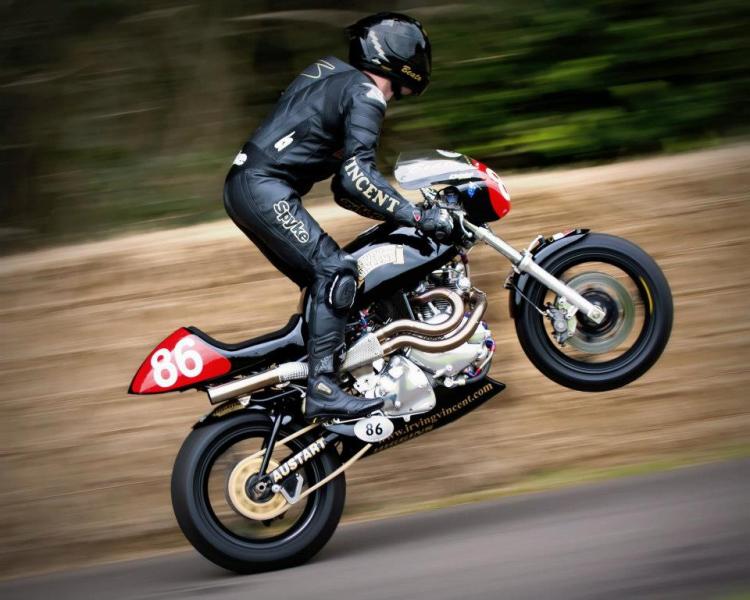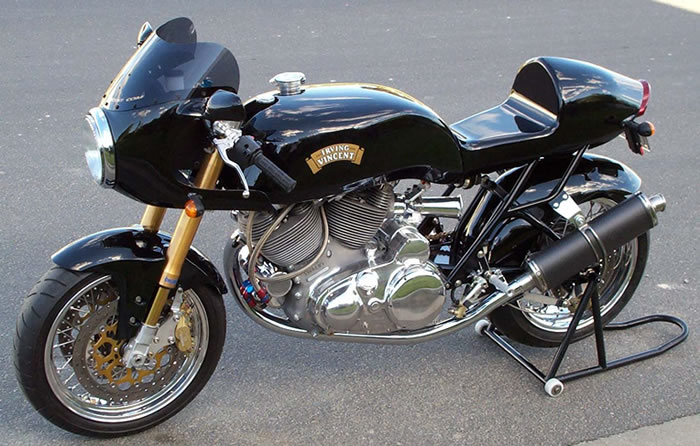For those who are not familiar with the Vincent Heritage, Phil Irving was one of the key people who made the Vincent legend; his contribution was equal to Philip Vincent himself as the Chief Engineer. Irving led the design of the Vincent engines and frames for the Series A, B and C and in honor to his memory and his Australian origin, his name was associated to Vincent, courtesy of his family. Today the Irving-Vincent is still based on a 1946 Vincent Series-B Rapide but, of course, extensively re-engineered to create this cheeky Superbike that dare to challenge the most modern pieces of Engineering.
Ken and Barry Horner own KH Equipment in Australia. Passionate about Vincent, they started to work on the Irving-Vincent project in 1999 to address the demand for Vincent parts and demonstrate their business capabilities. However, it did not take long before they bet that they would be able to design a complete bike, competitive enough to win in the Superbike Historic championship. From 2003, the Irving-Vincent started to align victories and finally in March 2008, the air-cooled two-valve pushrod V-twin made its outing on the Daytona Speedway, where it beat a horde of liquid-cooled multi-valve Superbike race replicas.
“The Horner Brothers believed in the Vincent engine and its ability to deliver massive power and torque at relative low revs, but the challenge was to turn a seventy years old engine into a monster of the modern track racing. It is where KHE expertise was able to make a difference, leveraging their technology and experience gathered from the Australian V8 Supercars championship and their capable skills in metallurgy and precision engineering. The later 1571cc delivers 165 bhp @ 6500rpm and 130 Lbs/ft on racing gasoline while the 8-valve engine achieves 186 bhp @ 7300rpm with 142 Lbs/ft @ 6500rpm.
Philippe Guyony © 2014
Header Photo © davekpcv



Picture © Bob Ayton

165 bhp and 113 lb/ft of torque @ 5800 rpm packed in a top-notch chassis were sufficient to beat the twins from Bologna.
Credit photo, David Dunfey

Credit photo, David Dunfey








If you are yet to be convinced that this thing flies…. look at the attached video clip.
Evolution 1 (the original and Period 4): 1298cc engine measuring 92 x 97.7mm under-square design with 14:1 compression ratio to run on a methanol mix, debuted in 2003 at the Geelong Speed Trials with around 135 bhp @ 6500rpm and 113 Lbs/ft of torque @ 5500rpm. 15 wins in 15 races between 2007 and 2008.
Evolution 2 (Period 5): same displacement with 1298cc but measuring 100 x 82.55mm super-square, delivering 145bhp @ 7000 rpm and 113 Lbs/ft of torque @ 6000rpm. 14 wins in 15 races between 2007 and 2008.
Evolution 3 (stroked | Injection): the engine is stroked to 100 x 100mm for a 1571cc displacement running on racing gasoline. Significant modifications include stroke and crankshaft, plain-bearing crank, Carrillo steel con-rods; Nikasil bore cylinders housing full-skirt JE three-ring flat-top pistons with 11.5:1 compression. V8 Supercar technology applied on various components such the cams and combustion chamber design. Fuel injection delivering 165 bhp and 113 Lbs/ft of torque @ 5800 rpm; Transmission is a KHE 5-speed based on a Quaife design.
Evolution 4 (8-valve): Same base with 4-valve heads. Compression Ratio: 13:1. BHP: 186 at 7000 rpm. Torque: 142 Lbs/ft at 6500 rpm.
Ken Horner Engineering Open Day, 2014. It will provide you some insight about the kind of business KHE is involved.
Sources:
http://motoring.ninemsn.com.au
http://www.odd-bike.com/2013/03/the-irving-vincent-anachronistic.html




